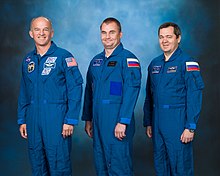 Soyuz TMA-20M spacecraft approaches the ISS Soyuz TMA-20M spacecraft approaches the ISS | |
| Operator | Roscosmos |
|---|---|
| COSPAR ID | 2016-018A |
| SATCAT no. | 41391 |
| Mission duration | 172 days 3 hours 47 minutes |
| Spacecraft properties | |
| Spacecraft type | Soyuz-TMA-M 11F747 No.720 |
| Manufacturer | Energia |
| Crew | |
| Crew size | 3 |
| Members | Aleksey Ovchinin Oleg Skripochka Jeffrey N. Williams |
| Callsign | Burlak |
| Start of mission | |
| Launch date | March 18, 2016 21:26:38 UTC |
| Rocket | Soyuz-FG |
| Launch site | Baikonur 1/5 |
| End of mission | |
| Landing date | September 7, 2016 01:13 UTC |
| Landing site | Kazakhstan |
| Orbital parameters | |
| Reference system | Geocentric |
| Regime | Low Earth |
| Docking with ISS | |
| Docking port | Poisk zenith |
| Docking date | March 19, 2016 03:09 UTC |
| Undocking date | September 6, 2016 21:51:30 UTC |
| Time docked | 5 months, 2 weeks, 4 days, 18 hours, 42 minutes |
 (l-r) Williams, Ovchinin and SkripochkaSoyuz programme (Crewed missions)← Soyuz TMA-19MSoyuz MS-01 → | |
Soyuz TMA-20M was a 2016 Russian Soyuz spaceflight to the International Space Station (ISS). It transported three members of the Expedition 47 crew to the ISS. TMA-20M was the 129th flight of a Soyuz spacecraft. The crew consisted of a Russian commander and flight engineer, as well as an American flight engineer.
It was the final flight of the Soyuz TMA-M design, being replaced by the Soyuz MS in 2016.
Crew
| Position | Crew Member | |
|---|---|---|
| Commander | Expedition 47 First spaceflight | |
| Flight Engineer 1 | Expedition 47 Second spaceflight | |
| Flight Engineer 2 | Expedition 47 Fourth and last spaceflight | |
Backup crew
| Position | Crew Member | |
|---|---|---|
| Commander | ||
| Flight Engineer 1 | ||
| Flight Engineer 2 | ||
References
- "Soyuz-TMA 01M - 20M (7K-STMA, 11F747)". Gunter's Space Page. Retrieved 19 March 2016.
- "Launch, Docking Returns International Space Station Crew to Full Strength". NASA. 18 March 2016. Retrieved 19 March 2016.
- "Russian Launch Manifest". Retrieved 13 March 2014.
- Планируемые полёты (in Russian). astronaut.ru. Retrieved 13 March 2014.
- astronaut.ru (2013). "Орбитальные полёты".
| Soyuz programme | |||||||||||||||||||||||||||
|---|---|---|---|---|---|---|---|---|---|---|---|---|---|---|---|---|---|---|---|---|---|---|---|---|---|---|---|
| Main topics |  | ||||||||||||||||||||||||||
| Past missions (by spacecraft type) |
| ||||||||||||||||||||||||||
| Current missions | |||||||||||||||||||||||||||
| Future missions | |||||||||||||||||||||||||||
| Uncrewed missions are designated as Kosmos instead of Soyuz; exceptions are noted "(uncrewed)". The † sign designates failed missions. Italics designates cancelled missions. | |||||||||||||||||||||||||||
| Human spaceflights to the International Space Station | ||
|---|---|---|
| See also: ISS expeditions, Uncrewed ISS flights | ||
| 1998–2004 |
|  |
| 2005–2009 | ||
| 2010–2014 | ||
| 2015–2019 |
| |
| Since 2020 |
| |
| Future | ||
| Individuals | ||
| Vehicles |
| |
| ||
| ← 2015Orbital launches in 20162017 → | |
|---|---|
| January | |
| February | |
| March | |
| April | |
| May | |
| June | |
| July | |
| August | |
| September | |
| October | |
| November |
|
| December |
|
| Launches are separated by dots ( • ), payloads by commas ( , ), multiple names for the same satellite by slashes ( / ). Crewed flights are underlined. Launch failures are marked with the † sign. Payloads deployed from other spacecraft are (enclosed in parentheses). | |